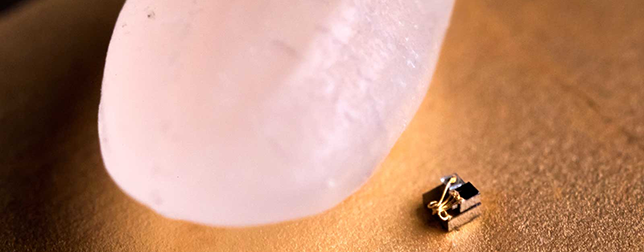After IBM made the “world’s smallest computer” in March, a team at the University of Michigan has gone even smaller, with a tiny computer measuring just 0.3 mm to a side – dwarfed by a grain of rice. The researchers see potential use of this device in a range of medical applications.
The “world’s smallest computer” trophy was originally held by the university with its 2mm x 2mm x 4mm Michigan Micro Mote. But, earlier this year, IBM introduced a tiny computer that’s smaller than a grain of salt measuring 1mm x 1mm.
Read more Tiny Sensors Pave Way For New Wearable Medical Diagnostic Devices
The new temperature sensing computer by University of Michigan measures 0.04 cubic millimeters, or about a tenth the size of IBM’s tiny computer. It’s so small that one grain of rice seems gigantic in comparison – and it’s so sensitive that its transmission LED could instigate currents in its circuits.
One of the challenges in making a computer this small is finding a very low power source to run it. As the device is too small to be fitted with a radio antenna like conventional computers, the tiny computer runs on visible light that is received from a base station. This light, and also light that comes from transmitters, can generate electric currents within the computer’s small circuits. To do that, researchers had to get creative to reduce the effect of light. Instead of diodes they used switched capacitors, and had to combat the relative increase in electrical noise that comes from running on a device that uses so little power.
“We basically had to invent new ways of approaching circuit design that would be equally low power but could also tolerate light,” says David Blaauw, professor of computer and electrical engineering at the University of Michigan.

Future Applications
The tiny computer is flexible enough to fit in various applications. For example, the university’s first tiny computer, the Micro Mote was used for a wide range of applications in the medical field such as, monitoring of biochemical processes, testing eye pressure for glaucoma patients, and cancer research. The Micro Mote was also useful in checking oil reservoirs, snail research, and audio and visual surveillance.
Researchers opted to test the new device first in oncological applications, especially in diagnosing tumors and assessing new types of cancer treatment.
Read more GreenTEG Selected for Vertical Accelerator Spring 2018 Program
Past research have shown that tumors may be warmer than their surrounding tissue, which means they could possibly be detected by measuring the temperature of cells and comparing it with the surrounding tissue.
As the device can measure temperature with a high degree of accuracy, researchers believe it would be able to detect temperature in a very tiny space, such as a clump of tumorous cells.
“Since the temperature sensor is small and biocompatible, we can implant it into a mouse and cancer cells grow around it,” says Gary Luker, biomechanical engineer and radiologist who has been working with the team.












